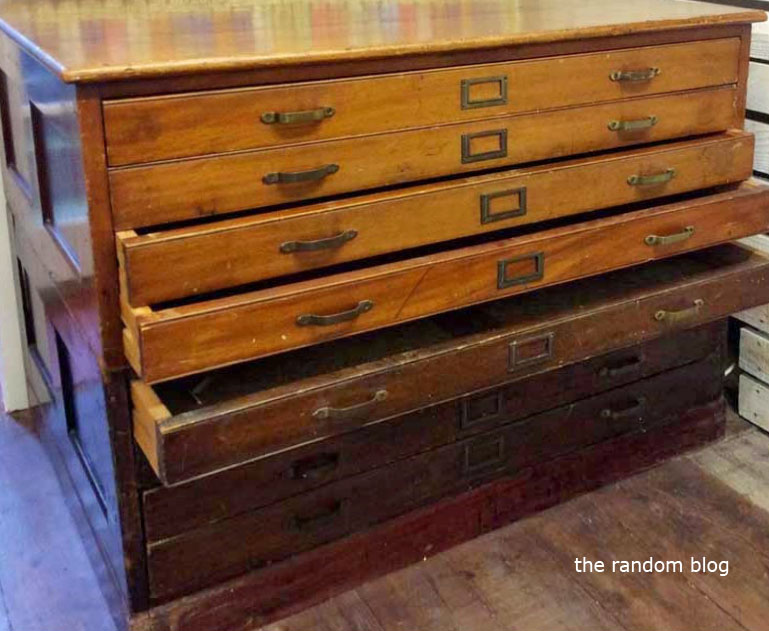
Hidden on the underside of one of the drawers in this mahogany architects plan chest was a Simpoles Ltd furniture makers label. The slightly torn label contained a wealth of information that led me on an interesting journey of discovery.
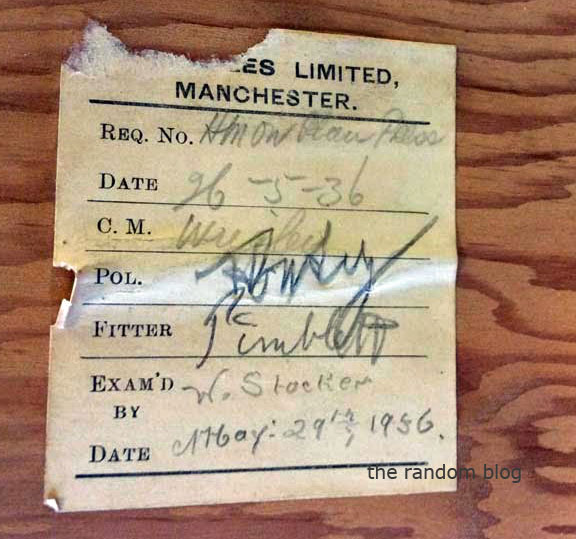
His Majesty’s Office Of Works
The label told me that it was made sometime prior to May 1936 and was supplied to “HMOW” as a “plan press”. The drawers have “G.R” for George V stamped on the brass label holders.
It turns out that “HMOW” has been through a lot of changes, but in 1936 it was H.M Office of Works with architect offices located in Edinburgh, London, Bristol and Manchester.
H.M Office of Works became the Ministry of Works in 1943; renamed the Ministry of Public Building and Works in 1962, and was absorbed into the Department of the Environment in 1970. Most Works functions were transferred to the Property Services Agency, set up in 1972 with the job of providing, equipping and maintaining a wide range of buildings and installations for Government Departments, and the Armed Services. The PSA has a bit of a chequered history and was subject to an enquiry that lead to the department being privatised in the 1990’s.
I can’t be sure which of the 4 offices this chest was originally supplied to but in 1936 the Manchester office, located at 76 Newton Street was headed up by William Shaw Cruickshank who became the District Surveyor in charge of the North West in 1933, and was in charge of eight assistants and draughtsmen. You can read more about him on the Dictionary of Scottish Architects
George V died in January 1936 and was succeeded by Edward VIII, who abdicated in December 1936, leaving George VI to take up the throne. However, in typical British “make do and mend” style, items stamped with G.R continued to be used until around the end of 1937 when new items produced were then stamped with George VI. Very few crown property items (such as GPO post-boxes) were stamped with Edward VIII.
Public service draughtsmen and architects during the late 1930’s were responsible for all manner of public buildings, so we can only imagine what designs might have been stored in the chest over it’s many years of service. Just 3 years after the chest was delivered, the second world war broke out – several well known war artists started out as draughtsmen and many returned to government offices after the war to work on plans for the massive amount of re-building projects that were undertaken after 1945.
Simpoles of Manchester
The furniture maker Simpoles of Manchester have a long history of making quality office and commercial shop furniture and chairs.
Using a wonderful collection of trade directories available online as part of the University of Leicester’s special collection I have found out that Charles Simpole, the son of a pork butcher, was born around 1817 and started to operate as a furniture dealer & cabinet maker from his home at 13 Bradford Street and a workshop at 5 Victoria Terrace, Victoria Street, in Manchester from around 1850. The terrace at the end of Victoria Street contained various traders including an ironmongers, artist, architect & tea dealer together with residential homes. By 1863, he is still listed at Victoria Terrace, with the furniture broker & auctioneer side of the business operating from Cathedral Yard (later to be called Cathedral Steps). The business remained at Cathedral Steps until the end of the 1800’s.
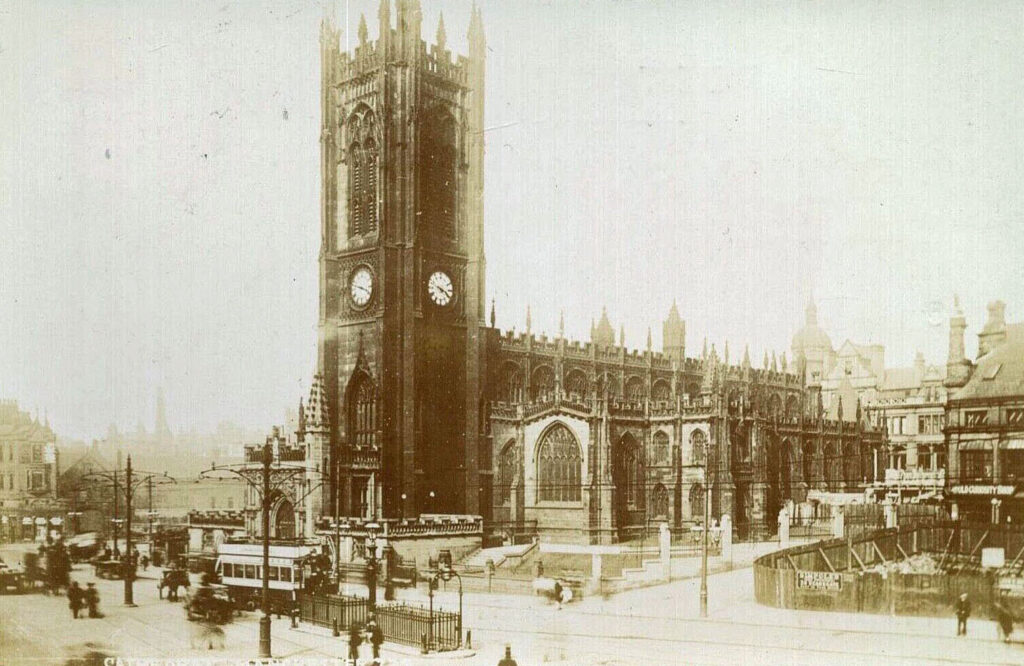
Charles Simpole died around 1888 and by 1903 the company had re-organised and expanded. It was listed in 1903 as Simpoles, office furnishers and cabinet makers (late of Cathedral steps), 38 Deansgate ; 11 Victoria Bridge, and 45 Chapel st.
Simpoles were in good company, as the furniture makers Gillows of Lancaster, (later to become Waring & Gillows) also had their showroom further along Deansgate, which in the 1900’s was a busy retail metropolis with many well known brands and trams operating along this main road in Manchester.
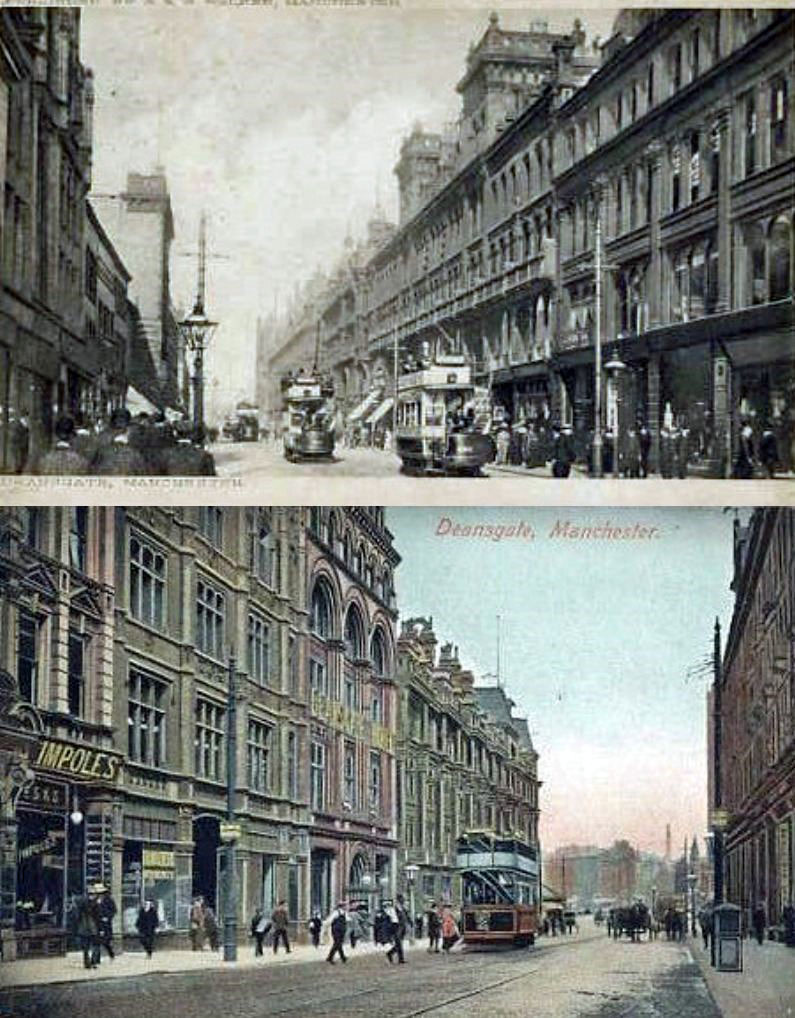
Padiham Town Hall
Between 1936 and 1938 “Messrs Simpoles Ltd of Manchester, contractors to the British Government” were responsible for providing all of the wood and furnishings inside the Padiham Civic Centre (the town hall in Padiham, Burnley). The building was designed by architects Bradshaw, Gass & Hope and opened with much fanfare by the London Council Chairman in March 1938. According to an article published in the local press about the opening ceremony, the council chamber featured Australian walnut panelling, with walnut and leather armchairs and tables, while three French windows opened onto balconies overlooking the street to provide facilities for public announcements.
The assembly hall, complete with stage, offered seating for 450, and was panelled in bronze chequered Gaboon veneered plywoods and had a sprung maple floor for dancing.
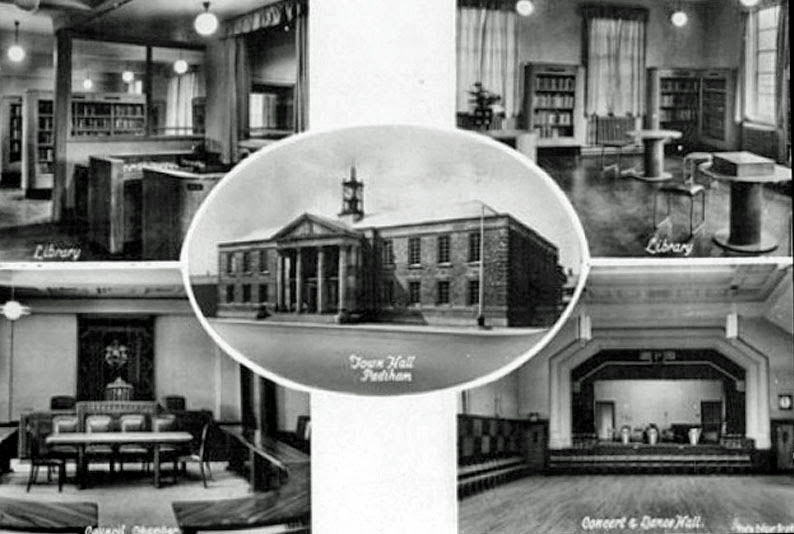
Simpoles Limited expanded into Liverpool sometime during the 1900’s where Warings operated from before joining up with Gillows. Simpoles furniture can be found labeled Simpoles Manchester & Liverpool during this period. After the second world war, Simpoles continued to trade from Manchester. After over a hundred years of trading, the company eventually ran into difficulties and was dissolved at the end of the 1990s.
It is hard to know how long the Simpoles plan chest remained in “His/her Majesty’s Service”, but at some point, it was sold or given away and ended up being used for storage in a builders merchants in Surrey until the builders merchants closed down around 1987.
2 replies on “The History of Simpoles Ltd – Furniture Makers”
Hiya, really interested in the Liverpool angle, as I have inherited an oak roll top desk with what looks like a gold leaf manufacturers mark, “Simpoles Liverpool”. My dad was a sugar buyer in Liverpool after the war but family suggests the desk was his father’s before it was his, which we thought meant pre-war. What can you tell me about the Liverpool branch please.
Thanks, Gaius.
Hi, Sadly I can’t tell you where the Liverpool branch was located or exactly when it was opened, but after doing a bit of searching, it looks like Simpoles were in Liverpool pre-war during the 1900’s – most likely Bond Street. I have seen furniture labels with Manchester & Liverpool on them from around the 1930’s which would fit in with your family story. Your best bet is to track down some Liverpool trade directories from that period to see when Simpoles started to appear – you might find these on ancestry or similar. I would also check your desks “hidden” areas such as the underside of drawers to see if you can find the cabinet makers label which may have the year on it. The company had a variety of styles for their “gold” company name stamp throughout their long history which also might help date it if you can find one similar.